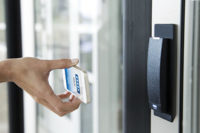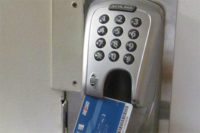Like every aspect of security, turnstile technology has gotten smarter over the years. The turnstiles you see in transit facilities are not the same as those high-end office buildings. The introduction of optical turnstiles changed that. But what has changed recently with optical turnstiles, and where is that technology headed?
SDM recently discussed this subject with Ralph Spagnola, vice president of sales and business development, Smarter Security, Austin, Texas; and Nick Simon, national sales manager, Alvarado Manufacturing Company, Chino, Calif.
SDM: What do you see as the latest overall trends and developments in optical turnstiles?
Spagnola: IP connectivity is a pretty significant trend in terms of not having to use a proprietary desktop module. Another thing we have been doing is taking some of our turnstile technology and making it available in other form factors such as a mini optical reader for use in hallways and corridors. In general I think the trend has been to continue to get the form factor to be compact, as well as to provide features such as tailgating and anti-passback.
Simon: Over the last couple of years companies have gone from just wanting to enhance lobby security to not wanting to compromise aesthetics. The trend has been to create turnstiles that allow for very secure control but do so in an aesthetic fashion that blends into the customer’s space. For example, our latest optical turnstiles have a cabinet that is only four inches wide, opening up the lobby visually and aesthetically.
SDM: What are some of the current features and benefits available with these technologies?
Spagnola: You can now do remote operations. The turnstile can be operated from the reception desk. And you can do that all via Web browser. Another significant benefit is maintenance. Via the Web you can do diagnostics to troubleshoot problems, check status and plan preventive maintenance. It also allows you to have features such as integrated elevator dispatch, where the user selects the floor they want to go to right at the turnstile and the elevator will be waiting for them when they get there.
Simon: A lot of the advancements are in how optical turnstiles are tracking people moving in and out. There are more advanced optical sensors and algorithms that detect people and differentiate between a person and a stroller or seeing-eye dog so as to not create false alarms. More advanced tailgate detection allows users to get more direct control of a lobby because they know it is not a false alarm. And when you have turnstiles that process people the correct way, it creates higher throughput rates. Turnstiles today also have LCD screens that provide visual messaging and corporate logos. They can also provide instructions for users. In general there is more customization.
SDM: Where do you see optical turnstile technology heading in the future?
Spagnola: For us, the big thing will be more IP connectivity. That allows an individual to access the turnstiles via the Web from any browser. By doing that, they can gain access to operating certain user features and maintenance features.
Simon: I am excited for the future. There have already been a lot of advances in how people are detected and how turnstiles sense people moving through. Integration with other access systems will continue to advance. Facial recognition will be able to see you from 30 feet away and unlock the turnstile. I think the whole industry will get smarter around how we are detecting people and ensuring we only let the right people in. Emerging technology will also need to fit into a company’s lobby without looking like a sore thumb.
| What Are the Different Types of Optical Turnstiles? |
|
Optical turnstiles are physical security devices that restrict or control access to a building or secure area using infrared sensors to detect people and objects, instead of a rotating mechanical barrier that is always present. There are three basic types of optical turnstiles:
• Optical Counting Turnstiles are used to count people, generally at the entry point of a facility or area. • Barrier-Free Optical Turnstiles passively control patron access in conjunction with a facility access control system. System users present access credentials to a reader installed in or in front of the turnstile. If the credential is valid, the turnstile allows a single user to pass through the lane. Unauthorized entry or attempts to “tailgate” behind an authorized user will set off lights and sounds to alert both the user and personnel of an alarm condition. Barrier-free optical turnstiles do not have a physical barrier, and are perceived by some people as more inviting than turnstiles with a barrier. However, barrier-free optical turnstiles are passive security devices and a nearby attendant (or an attendant monitoring via camera) should be present so that alarm conditions may be addressed appropriately. • Optical Turnstiles with Barriers actively control patron access in conjunction with a facility access control system. Motorized barriers are used in conjunction with the optical sensors to present a physical barrier to users until a valid credential is presented. System users present access credentials to a reader installed in the turnstile. If the credential is valid, the barriers open and the turnstile allows a single user to pass through the lane. Once the user has passed, the barriers automatically close and the turnstile waits for the next credential. Unauthorized entry or attempts to “tailgate” behind an authorized user will set off lights and sounds to alert both the user and personnel of an alarm condition. Optical turnstiles with barriers present both a physical and psychological barrier to entry. They clearly inform staff and visitors that entry is restricted. They also may allow staff to be reduced in employee entrance areas. Information Courtesy of Alvarado Manufacturing Company, Chino, Calif. |









